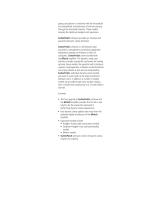 Website:
SUTTER INSTRUMENT
Website:
SUTTER INSTRUMENT
Catalog excerpts

The first all-in-one solution for performing dynamic clamp experiments! DYNAMIC CLAMP FOR THE dPATCH DIGITAL PATCH CLAMP AMPLIFIER The dynamic clamp technique was first introduced in 1993 as a method for simulating ionic conductances in neurons during patch clamp recordings. This method typically involves recording the cell's membrane potential, transmitting the data to a computer, calculating the appropriate current to be injected into the neuron, and sending this value back to the amplifier. Communication between the computer and amplifier limits the rate at which the dynamic clamp calculations can be updated. Moreover, the additional hardware and software needed to do dynamic clamp has limited its application. An all-in-one solution is now available as a free upgrade to SutterPatch® software and the dPatch® amplifier for researchers interested in performing dynamic clamp experiments. The patented digital architecture of the dPatch amplifier provides an ideal platform for dynamic clamp. The dPatch is powered by a system-on-chip which provides parallel processing across a Field Programmable Gate Array (FPGA) and two highspeed ARM core processors. Several sophisticated dynamic clamp models are implemented within this architecture. In each model, the update of the applied current values occurs without communication between the dPatch and a computer. Depending upon the complexity of the model, update rates of up to 500 kHz can be achieved. Simulation of a population of channels within the neuronal membrane involves modeling the kinetics of the channel's gating mechanisms. These channel kinetics can either be modeled using multiple independent gates as in the Hodgkin-Huxley model, or a multi-state Markov model. For Hodgkin-Huxley style models, the dPatch provides for up to 16 individual gates per simulated channel, with up to eight simulated channels running simultaneously per headstage. For Markov models, up to four 14-state models can be run simultaneously or eight models with fewer states can be run. For instance, eight 10-state models can run simultaneously. The values derived from the gating equations are then used to calculate the current applied to the neuron. The calculation of current can either be defined in terms of conductance or permeability. For conductance models, the value defined from the gating calculations is combined with the reversal potential of the ions passing through the simulated channels, as well as the conductance of the simulated channels. Furthermore, channel conductance values can be voltage dependent. For permeability models, the value defined from the (CONTINUED ON BACK) One Digital Drive • Novato • CA 94949 • Phone +1.415.883.0128 Fax +1.415.883.0572 • Web www.sutter.com • Email info@sutter.com
Open the catalog to page 1
gating calculations is combined with the intracellular and extracellular concentrations of the ions passing through the simulated channels. These models simulate the Goldman-Hodgkin-Katz equations. SutterPatch software provides an intuitive and powerful dynamic clamp interface. SutterPatch software is a full featured data acquisition, management and analysis application designed to operate on Windows or Mac OS computers. SutterPatch comes bundled with the dPatch amplifier. The dynamic clamp user interface provides a powerful mechanism for loading dynamic clamp models. No expertise with...
Open the catalog to page 2All SUTTER INSTRUMENT catalogs and technical brochures
-
SUTTERPATCH ®
2 Pages
-
dPATC H ®
2 Pages
-
MT-75 Comparison
1 Pages
-
BV-10
1 Pages
-
P-1000
1 Pages
-
P-97
1 Pages
-
QUAD®
1 Pages
-
MPC-200/MPC-385/MPC-325
1 Pages
-
MPC-78 / MP-78
1 Pages
-
IPA / DOUBLE IPA
2 Pages
-
Sutter Catalog
319 Pages
-
MICROPIPETTES
108 Pages
-
XenoWorks®
1 Pages
-
MP-265 / MPC-365
1 Pages
-
P-2000
1 Pages



























